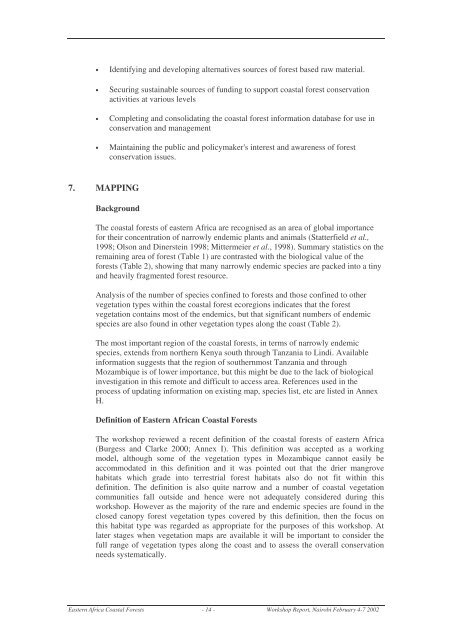Eastern Africa Coastal Forest Programme: Regional Workshop ...
Eastern Africa Coastal Forest Programme: Regional Workshop ...
Eastern Africa Coastal Forest Programme: Regional Workshop ...
You also want an ePaper? Increase the reach of your titles
YUMPU automatically turns print PDFs into web optimized ePapers that Google loves.
• Identifying and developing alternatives sources of forest based raw material.<br />
• Securing sustainable sources of funding to support coastal forest conservation<br />
activities at various levels<br />
• Completing and consolidating the coastal forest information database for use in<br />
conservation and management<br />
• Maintaining the public and policymaker's interest and awareness of forest<br />
conservation issues.<br />
7. MAPPING<br />
Background<br />
The coastal forests of eastern <strong>Africa</strong> are recognised as an area of global importance<br />
for their concentration of narrowly endemic plants and animals (Statterfield et al.,<br />
1998; Olson and Dinerstein 1998; Mittermeier et al., 1998). Summary statistics on the<br />
remaining area of forest (Table 1) are contrasted with the biological value of the<br />
forests (Table 2), showing that many narrowly endemic species are packed into a tiny<br />
and heavily fragmented forest resource.<br />
Analysis of the number of species confined to forests and those confined to other<br />
vegetation types within the coastal forest ecoregions indicates that the forest<br />
vegetation contains most of the endemics, but that significant numbers of endemic<br />
species are also found in other vegetation types along the coast (Table 2).<br />
The most important region of the coastal forests, in terms of narrowly endemic<br />
species, extends from northern Kenya south through Tanzania to Lindi. Available<br />
information suggests that the region of southernmost Tanzania and through<br />
Mozambique is of lower importance, but this might be due to the lack of biological<br />
investigation in this remote and difficult to access area. References used in the<br />
process of updating information on existing map, species list, etc are listed in Annex<br />
H.<br />
Definition of <strong>Eastern</strong> <strong>Africa</strong>n <strong>Coastal</strong> <strong>Forest</strong>s<br />
The workshop reviewed a recent definition of the coastal forests of eastern <strong>Africa</strong><br />
(Burgess and Clarke 2000; Annex I). This definition was accepted as a working<br />
model, although some of the vegetation types in Mozambique cannot easily be<br />
accommodated in this definition and it was pointed out that the drier mangrove<br />
habitats which grade into terrestrial forest habitats also do not fit within this<br />
definition. The definition is also quite narrow and a number of coastal vegetation<br />
communities fall outside and hence were not adequately considered during this<br />
workshop. However as the majority of the rare and endemic species are found in the<br />
closed canopy forest vegetation types covered by this definition, then the focus on<br />
this habitat type was regarded as appropriate for the purposes of this workshop. At<br />
later stages when vegetation maps are available it will be important to consider the<br />
full range of vegetation types along the coast and to assess the overall conservation<br />
needs systematically.<br />
<strong>Eastern</strong> <strong>Africa</strong> <strong>Coastal</strong> <strong>Forest</strong>s - 14 - <strong>Workshop</strong> Report, Nairobi February 4-7 2002
















